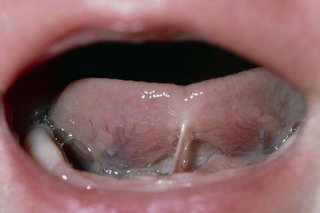Tongue-tie
Symptoms of tongue-tie

SCIENCE PHOTO LIBRARY https://www.sciencephoto.com/media/266498/view
If you or your child have tongue-tie, the piece of skin connecting the tongue to the bottom of the mouth usually looks shorter or tighter than usual.
The tongue may also look heart-shaped when it's lifted or stuck out.
Tongue-tie may not cause any problems, but it can make it difficult to move the tongue. For example, you may not be able to move your tongue from side-to-side, lift it up or stick it out.
In babies, tongue-tie can make it difficult for them to breastfeed or bottle-feed. They may:
- have difficulty attaching (latching) or staying attached to the breast or bottle teat
- feed for a long time and need to be fed very often
- dribble a lot during feeds
- cough, choke or make clicking noises when feeding
- only take a small amount of milk at each feed
- lose weight or struggle to put on weight
If your baby has tongue-tie and you're breastfeeding, you may have sore nipples or painful and swollen breasts.
Non-urgent advice: Speak to a midwife, health visitor or GP if:
- you think your baby or child has tongue-tie
- your baby is having difficulty breastfeeding or bottle-feeding
A GP may be able to help if you're an adult and you think you have tongue-tie.
Treatment for tongue-tie
Treatment is not usually needed if tongue-tie is not causing any problems.
If it's causing problems, such as difficulty feeding in babies, treatment may include:
- breastfeeding or bottle-feeding advice from a trained health professional
- a small surgery to cut the piece of skin connecting the tongue to the bottom of the mouth
In young babies, the surgery is usually done without any anaesthetic. In older babies (and children and adults) the surgery is usually done with general anaesthetic.
After surgery, most babies get better quickly and are able to feed better.
Page last reviewed: 20 March 2024
Next review due: 20 March 2027